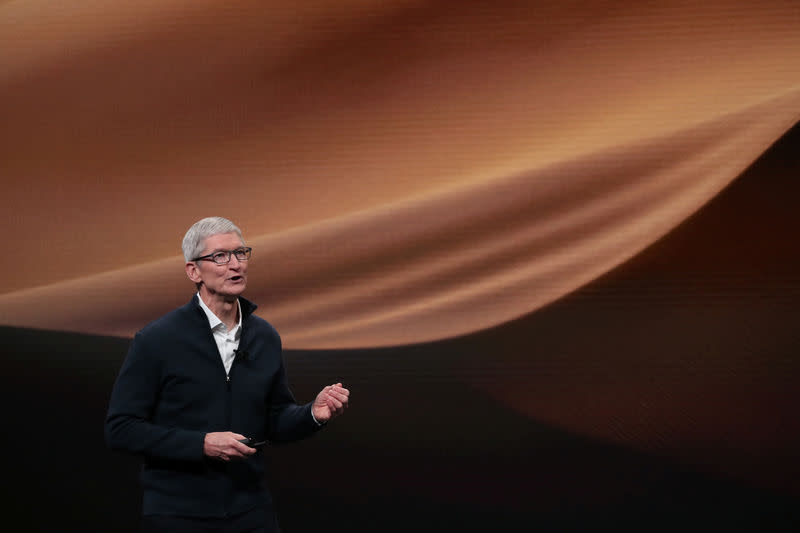Don’t freak out about Apple's iPhone sales numbers

Apple (AAPL), on Thursday, reported its Q4 2018 earnings, and while the average selling price for iPhones the company sold in the quarter beat expectations, the number of handsets sold fell short.
The stock was down on Friday, following that miss and the news that Apple will no longer break out individual iPhone, iPad and Mac sales in its earnings reports. The mixed quarter also included softer than expected projections for Q1 2019, which is the all-important holiday quarter.
But Apple has been preparing for this moment. It was likely obvious to the company that iPhone sales wouldn’t maintain the high levels of growth Apple has seen over the years. After all, there are only so many people in the world who can buy iPhones. That’s why it created an ecosystem that locks users in, making them more likely to stick to Apple-owned services and accessories like iTunes and the Apple Watch.
And that, barring some mass exodus of users from Apple’s hardware, is how the company will continue to grow in the future.
Higher prices are here to stay
Apple’s new iPhones — the XR, XS and XS Max — are pricey offerings. The XR, which is supposed to be the smartphone for the rest of us, starts at $749. That’s $50 more than the iPhone 8, the phone it presumably is meant to replace. The iPhone XS, meanwhile, starts at $999, while the iPhone XS Max starts at $1,099.
And the Apple faithful are more than willing to fork over that extra cash. Apple’s average iPhone selling price for Q4 2018 was $739, up more than 41%.
Total iPhone shipments, however, were off Wall Street expectations. Analysts had expected the tech giant to sell 48.4 million iPhones in Q4, but the company instead moved 46.9 million handsets. Apple also offered weaker guidance for Q1 2019, and announced that it will stop breaking out iPhone sales in its earnings report. That weak guidance, mixed with the sales miss, may have led some investors to believe Apple could be facing serious trouble.
“It’s inevitable that if Apple continues to rely on smartphone sales, they will slow unless [Apple] continue to raise the average selling price, and I don’t think we’ve seen the limits of average selling price,” explained Forrester vice president and principal analyst Julie Ask.
Apple’s decision to bump up its iPhone prices, though, was clearly made in anticipation of sales plateauing in mature markets like the U.S., Europe and the increasingly crowded Chinese smartphone market. With the success of the iPhone X following last year’s launch, Apple also realized it could sell expensive handsets and people would still eat them up, which means those high prices are here for good.
It’s true that Apple’s decision to no longer break out iPhone sales will make it more difficult to parse that portion of the business, which might make investors nervous. Apple’s strategy, however, seems to be to make Wall Street focus less on total iPhone sales, and look at the company as more than just a smartphone manufacturer.
Services as the driver
Apple CEO Tim Cook and company have been laying the groundwork for this move for some time now. During previous earnings calls, Cook referred to Apple’s Services business as a growing part of its business, one that could stand as a Fortune 100 company if it were broken out on its own.
And it’s the services part of the business that could become the real driving force for Apple as the iPhone’s growth slows. Since Q3 2015, Apple’s services sector has seen year-over-year double-digit growth.
In Q4 2018, services, which includes everything from iTunes, Apple Music, and the App Store to Apple Care, Apple Pay and iCloud, generated $10 billion in revenue, the segment’s highest quarter yet. With Apple expected to launch its own streaming service in 2019 and more customers using Apple Music, services could continue to see such growth for some time.
To be sure, the iPhone is still Apple’s biggest revenue generator, making the company $37 billion in Q4 2018, or more than half of overall revenue. But with more than 2 billion iOS devices in the marketplace already, services like Apple Music and iCloud have a ready-built audience they can tap into.
Then there is the rumor that Apple will launch its own streaming service in 2019. That offering is said to include $1 billion in original programming from big-name film and television creators like Steven Spielberg. The Information reports that the Apple will initially launch its service, which will compete directly with heavy-hitters like Netflix, in the U.S., and roll it out to 100 other countries thereafter.
If that takes off, it could push Apple’s services segment far higher than anticipated. Cook says services is expected to be a $50 billion business by 2020.
So while Apple’s iPhone sales might not see the kind of intense growth the company experienced in the handsets’ heyday, don’t count the tech giant out just yet.
More from Dan:
Apple iPhone sales disappoint, but selling prices were way up
Apple unveils redesigned iPad Pros with edge-to-edge displays
IBM CEO on Red Hat: ‘There’s a $1 trillion market in front of us’
Email Daniel Howley at dhowley@oath.com; follow him on Twitter at@DanielHowley.Follow Yahoo Finance on Facebook, Twitter, Instagram, andLinkedIn.

